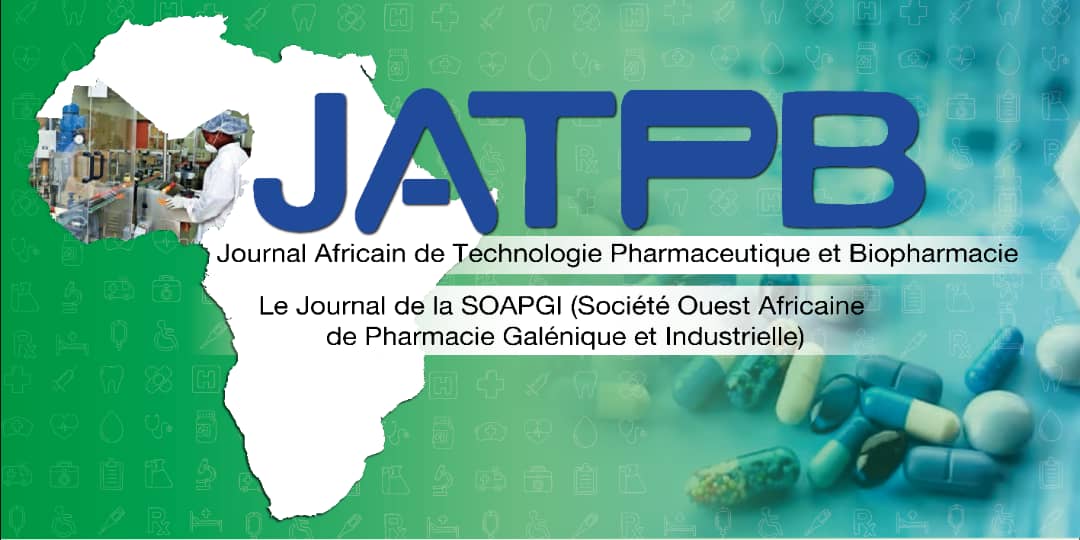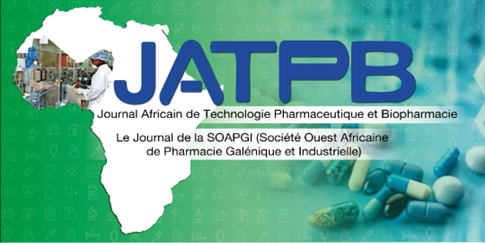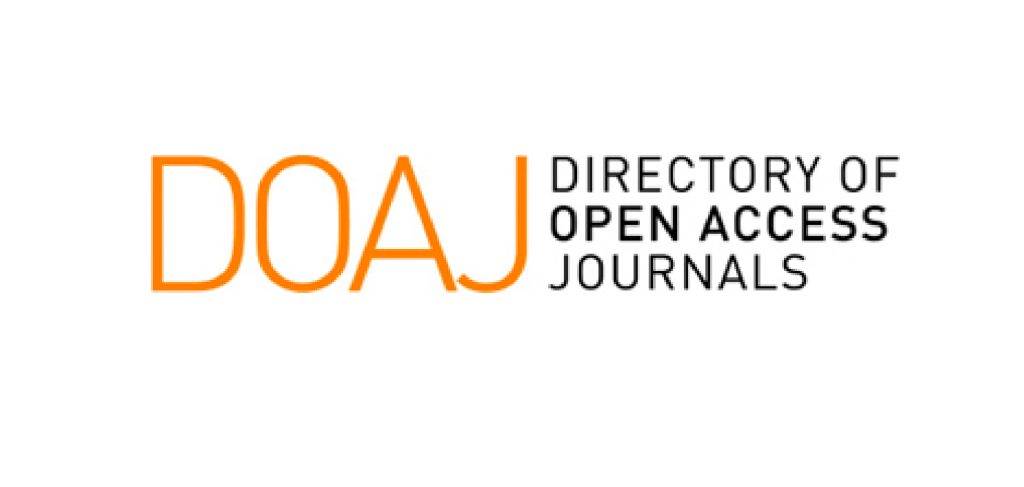Guide to Authors
Guidelines for authors
African Journal of Pharmaceutical Technology and Biopharmacy (AJPB)
May 2023
Table of contents
1-/ Types of articles and themes. 3
2.2-/ Standards for bibliographic references. 8
3-/ Sample submission letter 9
Download the guidelines for authors AJTPB here :
https://soapgi-jatpb.org/index.php/jatpb/libraryFiles/downloadPublic/13
The African Journal of Pharmaceutical Technology and Biopharmacy (AJPTB) aims to publish original scientific research articles, reviews and general reviews, editorials, reviews of articles, theses or books, communications, reviews, commentaries, proceedings of scientific meetings, letters to the editor (original facts or technical notes) dealing with pharmaceutical sciences, in particular research in formulation, pharmacotechnics, pharmaceutical industry, and pharmaceutical technology, biopharmacy.
A peer-reviewed scientific journal, the African Journal of Pharmaceutical Technology and Biopharmacy - JATPB strives to promote in this field of research the plurality of disciplines of approach and the development of multidisciplinary, even interdisciplinary perspectives, as well as the knowledge of works from different countries and the development of an international comparative perspective.
It aims to contribute to the visibility and structuring of the field by offering researchers who are interested in it - and in particular professionals carrying out research work - a publication medium recognised by the scientific community. It also aims to offer pharmaceutical science professionals, the most recent advances in research in galenic pharmacy, pharmaceutical technology and biopharmacy and their partners, better access to research work likely to inform and guide their practices.
The journal is published by the West African Society of Industrial Galenic Pharmacy (SOAPGI). Thus, the African Journal of Pharmaceutical Technology and Biopharmacy (JATPB) belongs to SOAPGI. The publication is biannual.
Articles submitted, in whole or in part for the most part, must not have been proposed or published in any other journal.
All articles sent to the journal must comply with the instructions set out below. The editorial board will not consider any paper that does not comply with these instructions.
In order to maintain sufficient variety, a single author may not write more than two articles in any one issue as first author.
All articles must be unpublished (i.e. they cannot refer to a previous publication, rewording does not constitute a new article) and submitted exclusively to the journal.
1-/ Types of articles and themes
1.1-/ Types of articles
Original article
This type of article publishes original (experimentally based) studies and research. Manuscripts should follow the IMRED outline which consists of four parts: Introduction, Methods, Results, Discussion and Conclusion. Methodological articles should be submitted as original research, but not necessarily following the IMRED outline.
Review articles
These are comprehensive reviews of research on a topic of interest. They may be narrative reviews where the author explicitly selects articles to argue the case for the topic, or systematic reviews with or without meta-analyses where the criteria for inclusion and exclusion of articles follow a well described methodology. Articles in this category do not necessarily follow the IMRED scheme.
Book review
A critical analysis and synthesis of a recently published book of particular interest to JATPB.
Editorial
The editorial presents a theme or opinion, even a controversial one, that is of major interest to JATPB. Editorials should not contain original results or clinical observations.
Letter to the editor
Letters to the editor are comments on published articles or current issues in one of JATPB's areas of interest. The authors of the article concerned by the letter are given the opportunity to respond to the editor and their response may be published.
1.2-/ Themes covered
The journal publishes articles on the following topics :
- Formulation of health products;
- Biopharmacy ;
- Pharmacokinetics
- Drug delivery systems;
- Nanotechnology and nanodrugs;
- Medical Devices;
- Pharmaceutical Technologies and Instrumentation;
- Pharmaceutical Management and Good Practice
- Quality control of medicines;
- Drug design and development; Drug industrialization
- Industrialization of medicines;
- Drug regulation;
- Computer science applied to pharmacy;
- Valorisation of the traditional Pharmacopoeia;
- Preparations and technologies in hospital pharmacy;
- Industrial synthesis of medicines;
- Pharmaceutical biotechnology;
- Distribution and marketing of medicines.
2-/ Presentation
The journal accepts manuscripts in French or English.
Copyright: Original manuscripts must not have been previously published. They should not be submitted for publication simultaneously to another scientific journal.
Manuscripts are reviewed by the Editorial Board and are submitted to a Reading Committee anonymously.
The decision to accept, correct or reject a manuscript takes 8 to 12 weeks.
Pages are numbered starting with the title page.
The author takes responsibility for the manuscript and certifies that all persons mentioned have read and approved the mention of their names in the article.
The manuscript must be submitted online on the journal's portal. The author must create an account on the journal's platform and upload the following three files :
- the submission letter signed by all authors of the article
- the title page: title in French and English, authors and affiliations, corresponding author, authors' contributions, acknowledgements if applicable. Authors are invited to propose three reviewers for the evaluation of their manuscript (Last name, First name, Title or function, affiliation, e-mail address and reasons) ;
- the text of the article (title and abstract in French and English, text of the article including tables and figures in the appropriate place). Avoid in the text of the article any mention that might allow the identification of the authors.
After selection by the editorial board, the texts received are submitted anonymously to three evaluators appointed within the scientific committee. The reviewers submit an evaluation report with an opinion (acceptance without revision, request for revision or rejection).
The Editorial Board receives the evaluation reports and informs the author anonymously of the evaluators' opinions and comments and of the decision; in the event of conflicting opinions, it sets up an arbitration mechanism. The editorial board decides on the final acceptance of the articles according to the conformity of the modifications to the requests made.
2.1.-/ Layout
All text should be written in Times New Roman, 12, double-spaced and justified. The entire manuscript should be submitted with the following layout:
- The text should not contain any indentations, indents or line breaks;
- The different levels of titles should be indicated by numbering of the type: 1; 1.1;
1.1.1.
Headings should be in the following format:
- Level 1 heading -Time New Roman, 12, Bold
- Level 2 Heading -Time New Roman, 12, Bold Italic
- Level 3 Heading -Time New Roman, 12, Italic
2.1.1.-/ Title page
The title page includes :
- the title of the article (Times New Roman, 12, Bold),
- the first and last names of the authors (Times New Roman, 12),
- the institutions and laboratories of the above authors (Times New Roman, 12),
- the telephone number and e-mail address of the corresponding author,
- the type and theme of the proposed article.
2.1.2.-/ Text of the article
- Title of the article (Time New Roman, 12, Bold)
- The abstract of maximum 250 words must be clear, precise and concise. It should clearly and briefly state the subject with a brief review of current knowledge. It is written without indentation in one block of text.
- Key words: 3-6 words on one line, below the abstract. Use terms from the Medicus Index: Medical Subject Headings (MeSH).
- Text should be clear, precise and concise.
- Abbreviations should be kept to a minimum and explained in the text when first mentioned.
- Scientific and technical terms should be those of the international nomenclature.
- Introduction : state the purpose of the article. Recall current knowledge on the subject. Give the background and context, specific aspects (existing research), the problem/research question, hypotheses and objectives.
- Materials and methods : describe the methodology very clearly. It is advisable to refer to a previous work if the methodology has been reported in detail there. This section should include sufficient information for the reader to understand the methodology. The statistical method should be specified. The general characteristics of the object of the study, the geographical site, the object of the study (latitude, longitude, plan, etc.), the variables studied and the data collection technique, the date, the experimental protocol, the sampling method and technique, the method and technique of observation, measurement, processing and analysis, etc.
- Results : abstract the observed results. When statistical significance is given, specify the method used.
- Tables : numbered in Arabic numerals in order of appearance in the text, their location must be specified by a reference in brackets (Table 1). They must be produced in Word and must not be photographed. They are accompanied by a brief, indicative title and any explanatory notes necessary to make it readable. The meaning of all abbreviations and signs must be specified in the notes. Limit the number of tables to the strict minimum and avoid redundancy between text and tables.
- Figure : numbered in Arabic numerals in order of appearance in the text, their location should be specified by a reference in brackets (Figure 1). They should be integrated into the text. Each figure must be accompanied by a caption in the language of publication of the article. Figures should be of excellent quality.
- Reproduction of previously published tables and figures must be accompanied by written permission from the copyright holder (publisher or author). Authors must make the necessary arrangements.
- Discussion : the "Discussion" section is the part of the scientific article that allows the author to situate his or her research among the existing research in the introduction or the state of the art. This positioning reveals the originality or otherwise of the research in the field. This is the heart of the article. The "Discussion" is the place where the results obtained must be given scientific meaning. The main roles of a "Discussion" are as follows: Interpret your results in the light of what was already known and published. Explain your new understanding of the problem after taking our results into consideration. Relate the results to the hypothesis in the introduction. Discuss the implications of the results presented for the research. Point out the weaknesses of the results obtained and open the way for new scientific questions. Address unexpected data and give their significance if possible. If not, these data can lead to scientific questions.
- Conclusion : reminder of the problem, the research question and the objectives. The conclusion reminds the reader of what is being discussed. The author thus reformulates the introduction and reminds the reader of the interest of the research. A brief abstract of the main points: summary of each result and its interpretation. The correlation between these results and the research question: it should be clear that the results contribute to answering the research question. The social impact of these results. The research impact of the contribution: how it advances knowledge in the field. Prospects: opening up opportunities for future research.
2.2-/ Standards for bibliographic references
The journal applies the Vancouver standards to bibliographic references. The Vancouver bibliographic style is one of the most widely used systems for classifying bibliographic references in basic and applied sciences, medicine and pharmacy.
In software such as Zotero or Mendeley, you can use the strict Vancouver style. To download the style(s) of your choice, go to the Zotero or Mendeley styles directory.
2.2.1-/ Managing references in the text
Throughout the text of your article, please reference all the concepts you have drawn on and all your quotations using a reference number in square brackets [1]. The numbers are given in order of appearance.
Any idea that is not your own, i.e. from a document written by someone other than you, should be clearly referenced.
If the same reference is cited several times in the text, it always bears the same number and appears only once in the bibliography.
2.2.2-/ Classification of references at the end of the document
Your article has a section at the end of the document which lists all your references in order of appearance.
This part is generally entitled References. Using the Vancouver style, it looks like this:
- Purves WK, Orians GH, Heller HC. The living world: a treatise on biology. Paris: Flammarion; 1994. 1224 p. [Book reference].
- Festa P. On some optimization problems in molecular biology. Mathematical Biosciences. 2007;207(2):219 34. [Article reference].
- Ney M. Role of BIN1 exon 7 inclusion in muscle weakness in patients with myotonic dystrophy [PhD thesis]. [Strasbourg]: University of Strasbourg; 2016. [Thesis reference]
- Haute Autorité de Santé. Evaluation of systematic newborn screening for bilateral permanent hearing loss [Internet]. HAS. 2007 [cited 18 Sep 2019]. Available from: https://www.has-sante.fr/jcms/c_513169/fr/evaluation-du-depistage-neonatal-systematique-de-la-surdite-permanente-bilaterale [Web page reference].
- Polak M. Synchronized diagnostic measurement for cochlear implants. EP 2262459, 2010. [Patent reference]
- Foulger D. An ecological model of the communication process. In: International Communication Spring Meeting [Internet]. New York; 2004 [cited 14 Nov 2013]. Available from: http://foulger.info/davis/papers/ecologicalModelOfCommunication.htm [Conference reference].
- AFNOR. Mechanical properties of corrosion-resistant stainless steel fasteners - Part 4: sheet metal screws. NF EN ISO 3506-4, 2010. [Standard reference*]
* For standards, use the "Patent" type in Zotero, and fill in the Title, Inventor, Patent No. and Date of Publication fields.
3-/ Sample submission letter
Before submission, please read the editorial policy.
The letter must be uploaded during submission as another file (see example below).
Dear Editor,
Please find enclosed the manuscript entitled "............................", by ................................
We sincerely hope that the manuscript will be considered for publication in the African Journal of Pharmaceutical Technology and Biopharmacy (AJPB).
All authors have given their consent for submission.
There is no conflict of interest. (If there is a conflict of interest, please specify).
This work has not been published elsewhere and has not been submitted to any other journal.
Thank you for considering this manuscript,
Sincerely yours.
Signatures of all the authors






